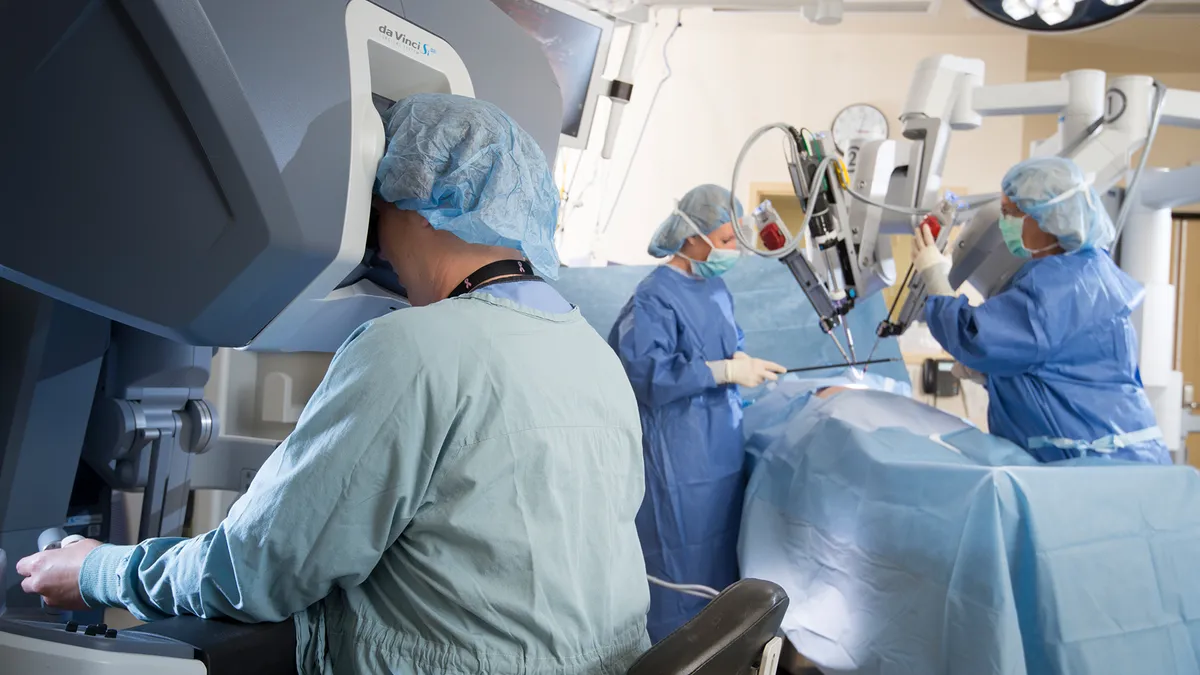Dive Brief:
- Robot-assisted procedures accounted for 15.1% of all general surgeries in 2018, up from just 1.8% in 2012, according to a study published Friday in JAMA Network Open.
- Researchers analyzed clinical registry data for 169,404 patients from Jan. 1, 2012, through June 30, 2018, who underwent robotic, open or laparoscopic procedures at 73 hospitals across Michigan. The data is from the Michigan Surgical Quality Collaborative, a partnership between the hospitals and Blue Cross/Blue Shield of Michigan that focuses on quality improvement for surgical care.
- The rapid uptake highlights a need for close monitoring of practice patterns in the adoption of robotic surgery to ensure enthusiasm for the technology does not get ahead of evidence showing clinical benefit, according to the study’s authors.
Dive Insight:
Robotic surgery for common surgical procedures is on the rise despite limited evidence to support its clinical benefit, the study authors assert. They point to FDA’s recent warning against use of the technology in breast and cervical cancer treatment, and note robot-assisted surgery may be the more expensive option compared to traditional open or laparoscopic approaches.
Yet hospitals that rolled out robotic surgery programs saw a broad and immediate increase in such procedures and corresponding decrease in laparoscopic surgery, which is also minimally invasive, the article said.
Use of robotic surgery climbed 8.8% in the first four years after hospitals introduced it, while laparoscopic procedures fell from 53.2% to 51.3%. Before adopting robotic surgery, hospitals’ use of laparoscopic surgery had increased 1.3% per year, the study found.
Among specific procedures tracked in the study, inguinal hernia repair saw the biggest gain in use of robotic surgery, rising from 0.7% of cases in 2012 to 28.8% in 2018. Other procedures where use of the robot is up sharply are ventral hernia repair, from 0.5% to 22.4%; colectomy, from 2.5% to 16.3%; reflux surgery, from 5.4% to 26.0%; and proctectomy, from 3.1% to 26.7%. Smaller increases were seen for cholecystectomy, rising from 2.5% to 7.5%, and complex cancer resections, increasing from 2.1% to 3.9%.
The researchers contend that for common and low-risk procedures such as cholecystectomy, or gallbladder removal, laparoscopic surgery is the accepted standard of care, less expensive, and can be performed by most general surgeons without robotics.
"This situation highlights a questionable trend: robotic surgery is replacing conventional laparoscopic approaches for procedures that may not be complex enough to warrant the consideration of an advanced, expensive, and unproven minimally invasive platform," the study authors wrote.
Regulators and surgeons will need to monitor the adoption of robotic surgery across various procedures to ensure that patient safety is not compromised, they said.
Intuitive Surgical’s da Vinci system is the dominant robotic platform for general surgery. TransEnterix has struggled to challenge its larger rival in the market with its Senhance system.
Other companies that have introduced robots with a more specialized focus include Medtronic, whose Mazor platform assists in spine and brain surgery; Stryker, with the Mako system for knee and hip replacement; Zimmer Biomet, with Rosa for spine and knee procedures; and Johnson & Johnson’s Monarch for lung biopsy.











